Shimadzu Optical Spectrum Analyzer is Contributing to Research into Terahertz Waves, a Region of the Electromagnetic Spectrum Ripe for Development
One of the fruits of the human intellect has been the exploitation of electromagnetic waves. Light and electromagnetic waves are, like the air around us, inexhaustible. Mankind, fascinated by this wonder, has systematized their basic principles through repeated experimentation and research. As a result, our lives have been enriched through the creation of a variety of tools. Examples include X-ray imaging, microwave ovens, and fiber optic communication, which makes use of light.
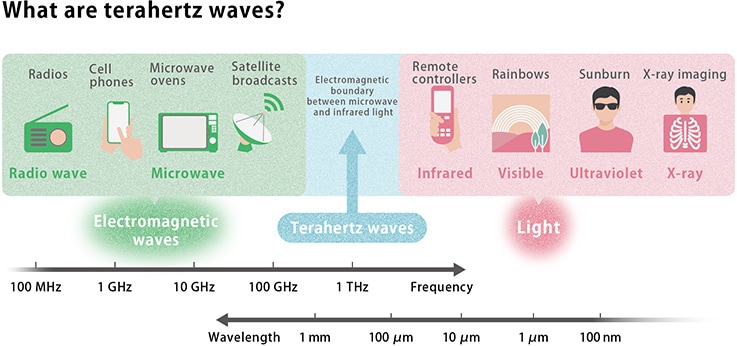
- A Future in which Exploitation of Terahertz Waves is Pursued
- Shimadzu Optical Spectrum Analyzers are utilized at the RIKEN laboratory, a Leading Global Research Facility for Terahertz Waves
- The Development Staff Prided Themselves on the High Spectral Resolution and the Real Time Measurement Technology
A Future in which Exploitation of Terahertz Waves is Pursued
As real-world applications of electromagnetic waves progress, terahertz waves are the only region of the spectrum in which real-world implementation has not progressed. Terahertz waves lie in a frequency band between light and radio waves. They are characterized by their combination of straightness as in laser beams, and the permeability of radio waves. However, they have extremely low energy for light and have a very high frequency for radio waves, making them both hard to generate and to detect. Accordingly, researchers into light and radio waves consider this region of the spectrum very hard to handle.

The importance of terahertz waves has heightened in recent years, however. The now popular 5G technology uses the millimeter wave frequency band, but there is a risk that communications will become overloaded in the future due to an increase in communications traffic. The utilization of the even higher frequency terahertz-wave bandwidth for next-generation 6G technology is currently a focus of attention. Research is accelerating globally aimed at putting this into effect. Furthermore, terahertz waves have the characteristic of penetrating paper, plastic, fiber, and other substances. However, their energy is lower in comparison to ultraviolet rays and X-rays, and so they have minimal effect on the human body. If terahertz waves are used, they would simplify security checks for people and postal items, and so they are expected to be put to practical use in counterterrorism for example.
Shimadzu Optical Spectrum Analyzers are utilized at the RIKEN laboratory, a Leading Global Research Facility for Terahertz Waves

Dr. Hiroaki Minamide, Team Director of the Tera-Photonics Research Team,
RIKEN Center for Advanced Photonics, RIKEN
Hiroaki Minamide of RIKEN* is continuing this research aiming at making practical use of these terahertz waves. Minamide began research into terahertz waves 25 years ago, and has discovered an efficient method of generating them, which has been difficult to date. In September 2024, he succeeded in developing a high-brightness terahertz-wave source small enough to fit in the palm of the hand. At present, he is continuing with further research aimed at making practical use of this.
* RIKEN, a National Research and Development Agency, is Japan's largest comprehensive research institution, founded in 1917.
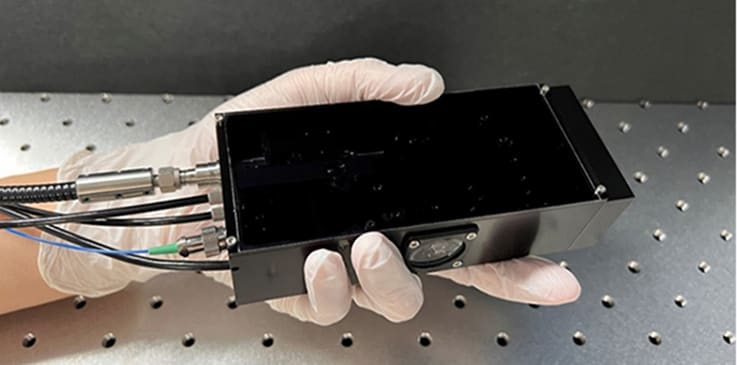
Handheld terahertz-wave source announced by RIKEN in September 2024 (Photo provided by RIKEN)
The Shimadzu SPG-V500 optical spectrum analyzer contributed to this research. Optical spectrum analyzers are instruments for analyzing the wavelength and intensity of light. They are generally used to analyze laser sources in fields such as optical communications.
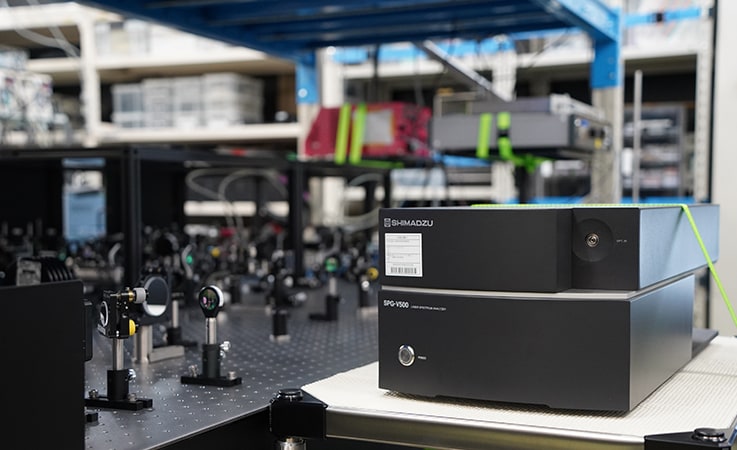
SPG-V500 Optical spectrum analyzer in the laboratory of the tera-photonics research team at RIKEN (Sendai Campus)
Minamide notes that "I learned that the wavelength of light could be measured in real time with the Shimadzu SPG-V500, and if that were the case, then research breakthroughs could be anticipated."
The tera-photonics research team that Minamide spearheads was right in the middle of developing a detector for use simultaneously with the source. The detection of a specific signal is indispensable in order to verify that terahertz waves are being generated. However, the team was unable to detect this signal despite their best efforts.
"If the signal cannot be detected, then the research cannot advance. To this end, two research staff spent a number of months making repeated adjustments and measurements, but without success. Just when I was at my wit’s end, a line in the proposal for the SPG-V500 reading ‘real time measurement function’ caught my eye. It seemed to me that I was clutching at straws, but I got in touch anyway. I borrowed a demonstration model, tried making adjustments and measurements as per usual, and I was surprised. The desired signal was found. I leaped for joy with everyone in the laboratory, shouting, ‘We did it! We found it!’"
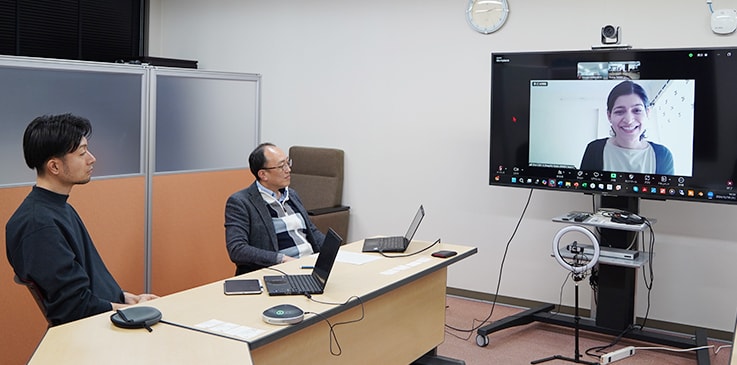
Dr. Hiroaki Minamide of the RIKEN (center) and researchers (at the time) Dr. Deepika Yadav (currently residing in India, on-screen) and Dr. Yuma Takida (far left) look back on the time in question.
The Development Staff Prided Themselves on the High Spectral Resolution and the Real Time Measurement Technology
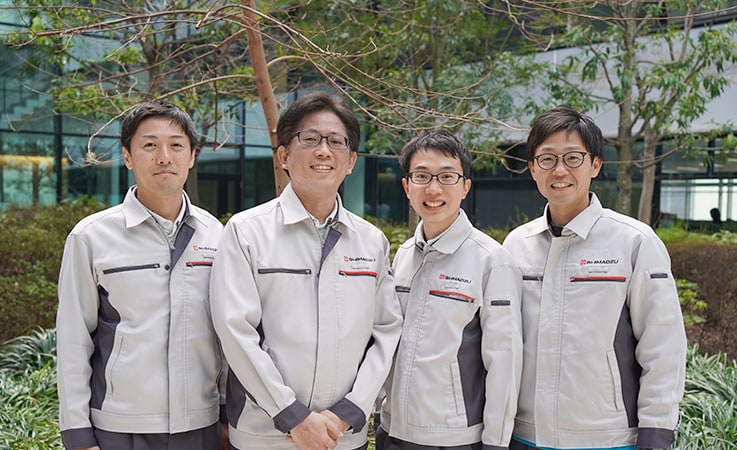
SPG-V500 development staff, from the left, Ryosuke Nishi, Tomoari Kobayashi, Hiroaki Nishihara, and Ryoji Hiraoka (Applications Group, Device Department)
Instruments that measure "light" also played a role in research into terahertz waves, a kind of electromagnetic wave. No one was more surprised by this news than the SPG-V500 developers. Development member Ryoji Hiraoka reflected that, "I wouldn't have dreamed that the SPG-V500 would play a role in terahertz-wave research."

Development staff Ryoji Hiraoka
The terahertz-wave source developed by Minamide uses a pulsed laser that instantaneously generates pulses with durations of a billionth of a second or less. Accordingly, taking measurements with a general-purpose optical spectrum analyzer was difficult.
Hiraoka, who was on the development team, said that "Development of the SPG-V500 started from the idea of creating an easy-to-use optical spectrum analyzer that could contribute to laser research. There are departments doing laser research at Shimadzu, and when I reached out to them, I heard that they were running into a variety of difficulties. To resolve these, I felt that what was needed was an instrument that could simultaneously provide high spectral resolution and wavelength information across a given range, and so I had found my development concept."
"General-purpose optical spectrum analyzers could not measure instantaneously generated light. The reason is the measurement method, which involves scanning the light over a period of time. Accordingly, with the SPG-V500, a polychromator type rather than a scan type measurement method was adopted. The instrument is equipped with an array sensor (an aggregate of small sensors), which enables it to obtain wavelength information across a certain range simultaneously."

Ryosuke Nishi, development and sales staff, responsible for SPG-V500 improvements
"This method uses proprietary Shimadzu technology, and is also effective for grasping occurrences of mode hopping (sudden changes in the wavelength of light), the main cause of laser noise. If mode hopping could be suppressed, this could be expected to improve the quality of laser sources, which could be useful in a variety of laser research fields, not only involving terahertz waves. I would like to contribute to a technological revolution in a wide range of fields, including sensing techniques for achieving self-driving vehicles, as well as optical communications."
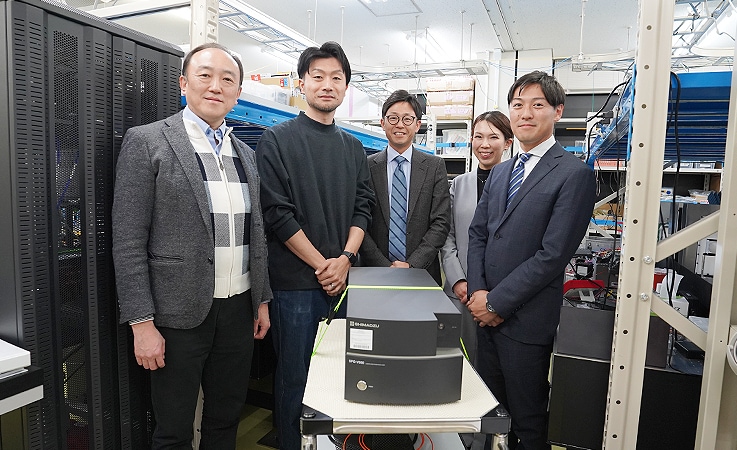
From the left, Hiroaki Minamide and Yuma Takida of RIKEN, and Ryoji Hiraoka, Satomi Sakamoto, and Ryosuke Nishi of Shimadzu Corporation. In the center is the SPG-V500 optical spectrum analyzer.
 Page Title and URL Copied.
Page Title and URL Copied.


